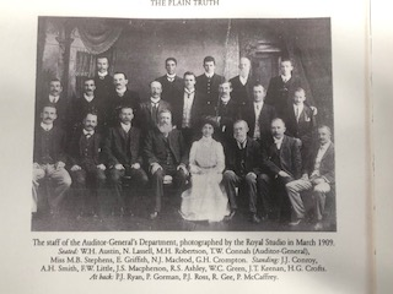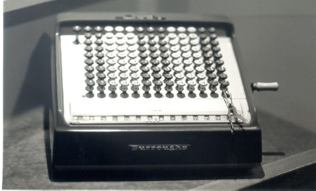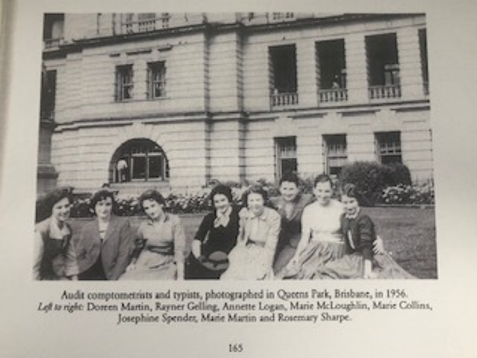For International Women’s Day this year, we share how women’s rights and gender equality have progressed at the Queensland Audit Office (QAO) over time.
The early years
It’s fair to say that the early years of the office were the sole domain of men. It was 44 years until the office had its first female employee. This occurred on the 1st of August 1904 when Miss M.B. Stephens started as the office’s typist on an annual salary of 70 pounds. A staff photo including Miss Stephens, taken in 1909, is below1.
The number of women in the office grew marginally over the next 60 years. The women who were employed filled roles as typists and comptometrists/machinists in the office. A comptometer was primarily an early version of a calculator – although much larger and more complex to operate. The Plain Truth, a History of the Queensland Audit Office1 describes how by 1949, the comptometerists were travelling with the auditors across Queensland. The Plain Truth also identifies that many of the ladies travelled with their mothers, but it also assures us that the gallantry of male staff was exemplary.
The picture below is of one of QAO’s remaining comptometers.
It’s almost ironic to think that while the office did not employ any female auditors, it seems the female employees were the ones responsible for operating the machines that did the actual number crunching!
The main reason women found it hard to gain employment as auditors during this time was the employment conditions in the Queensland public service. These included:
- a requirement for women to leave the public service once married
- inability for female employees to obtain permanent clerical status, which required sitting clerical aptitude tests – it took until 1971 before ‘long serving females’ were permitted to sit these
- women were only paid 75 per cent of the equivalent male wage.
There was also a very strict dress code, which frowned upon women wearing trousers in the workplace. It took until 1969 before the office appointed its first female audit clerk. This occurred when Doreen Martin, a machinist, was appointed after undertaking accountancy studies at night. The picture below from The Plain Truth, a History of the Queensland Audit Office1 includes Doreen along with other audit office comptometrists and typists in 1956.
Even once the office began employing female auditors, it was still difficult for them to progress as promotion was based on seniority – and the male employees had a significant head start.
The times are changing – women at the Queensland Audit Office
By the time the Department of the Auditor-General became the Queensland Audit Office in May 1993, things had started to change. In particular, the number of women holding audit positions had increased significantly and promotion was now based on merit rather than years of service.
By 1994, women represented 33 per cent of total QAO staff, but, while they had increased representation at the AO6 and AO7 levels, there were still no female audit managers. This would not occur until 1997–98 with the appointment of Debra Stolz as an Audit Manager AO8.
While there were no female audit managers in 1994, Jenny England became the first female in a senior executive non-audit position in the role of Assistant Auditor-General–Policy and Corporate Services. Terry Campbell was the first woman in a senior executive audit role when she was appointed as Director IS Audit in 2004 and, subsequently, Assistant Auditor-General–Performance Management Systems Audits in 2007.
During Terry’s tenure, QAO also set up a women’s leadership group. It led improved representation and retention of women in middle and senior management positions, and helped all staff with development and career advancement.
As at 30 June 2021, 56 per cent of all QAO employees are women – including 36 per cent of directors and above, and a third of our Executive Management Group. A large portion of our managers and senior managers are women too. This is a significant advancement and one we are very proud to celebrate on International Women’s Day.
1. The Plain Truth, a history of the Queensland Audit Office, Robert Longhurst, 1995.



